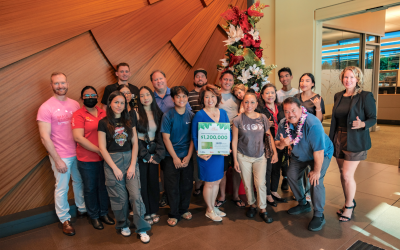Last month, we talked about proper handwashing. The next step in helping to prevent foodborne illness is proper glove usage.
Gloves are available either as latex or vinyl, and powdered or powdered free. Preference is up to the Chef and staff, however, some people have a latex allergy, or can develop one with use.
Gloves are also available in different colors such as blue or black. These colors are not fashion statements – if a glove section or finger is torn or cut off, these more noticeable colors can be noticed in foods easier. A good way to prevent gloves from breaking is to make sure the proper size is available and being used. If they are too tight, they will restrict the hands movement, too loose allows a fingertip of the glove to be unwittingly cut off. I personally will never go back to the fast food joint where I had a Chef’s Surprise – 2 inches of a latex glove in my burger!!
After you properly wash your hands, put the gloves on. Make sure your hands are dry, otherwise getting the glove on becomes much more difficult. Make sure they are fully on your hand with no air bubbles or looseness. As you work, if the glove starts to tear, remove it, wash hands and re-glove.
How to remove the gloves? With one hand, grab the cuff of the other hand and roll the glove into a ball over the fingertips, then toss and wash your hands. Do not dramatically snap off the gloves, as this sprays the bacteria on the glove all over the place. Also – do not reuse them!! A worker of mine actually very carefully took off her gloves, and left them at the side of her workstation during her break.
When to use them? Technically, it is whenever you are handling a Ready To Eat food – something that will receive no further cooking before being served. A better idea is to have gloves on whenever any food is being handled, period. Gloves minimize any bacteria that may be on the hands, and use of gloves makes cleaning your hands properly that much easier. Wearing a bandaid or having a cut on the hand means a glove must be on the hand with the cut. They need to be changed whenever working with differing Potentially Hazardous Foods – poultry, then beef for example.
Other ways to prevent bare hand contact are with use of tongs, spoons & forks, deli paper or napkins (single use only please) or scoopers. Foods frequently overlooked are ice in drinks and beverage condiments. Scoops for the ice and tongs for the lemons should be part of the proper setup at bars and beverage stations.
I’ll bet that you didn’t think gloves were so involved!! Once you and your staff get it down, it will become second nature.
To learn more detail about this and other Food Safety procedures, or to set up an independent discounted audit of your facility, please contact Peter Bellisario of PeterB Food Safety Audits at peterb101@aol.com or (808)491-7766.




0 Comments